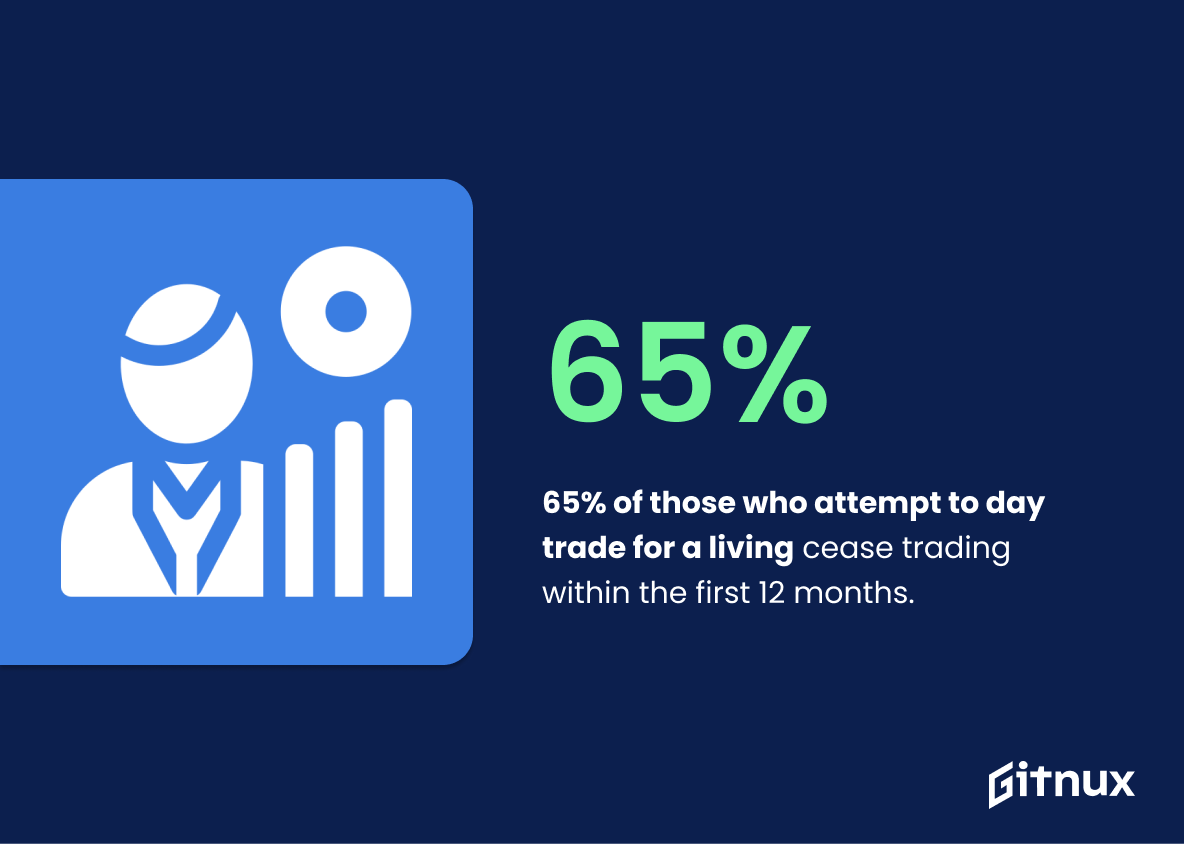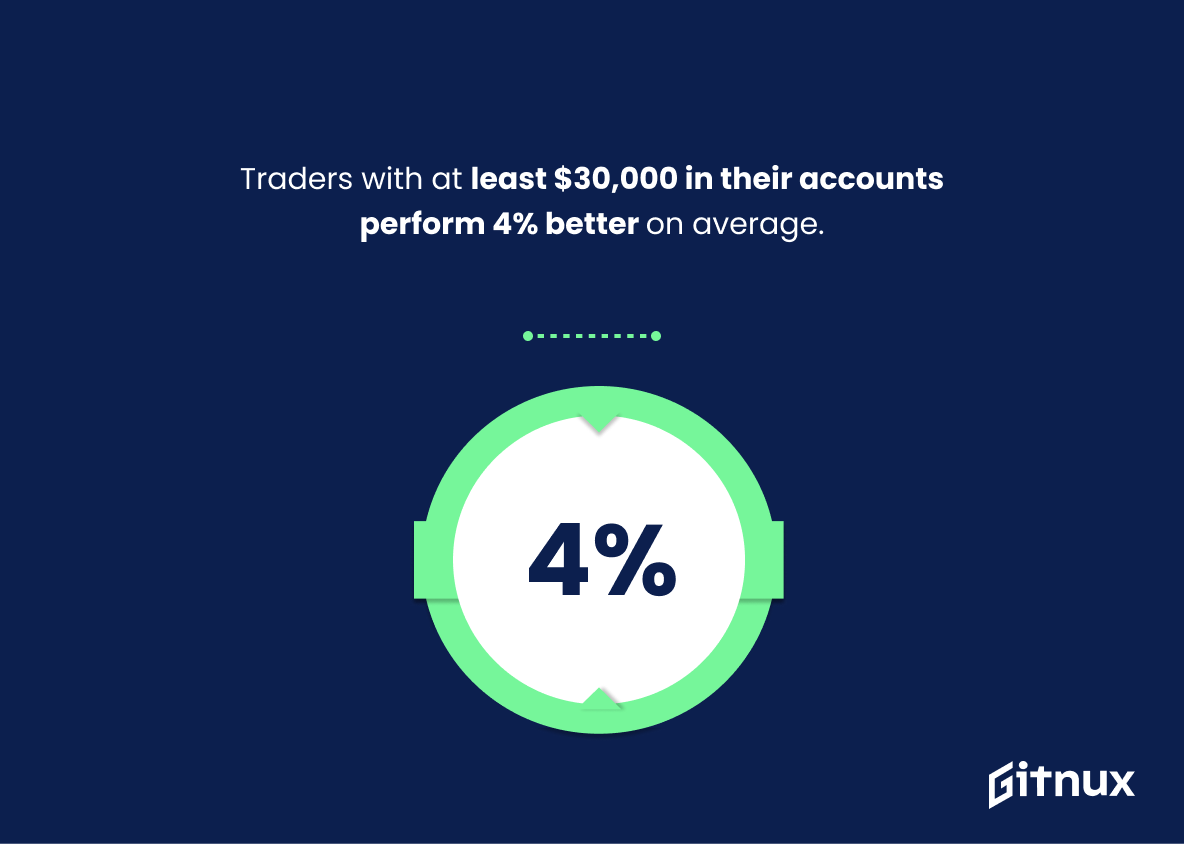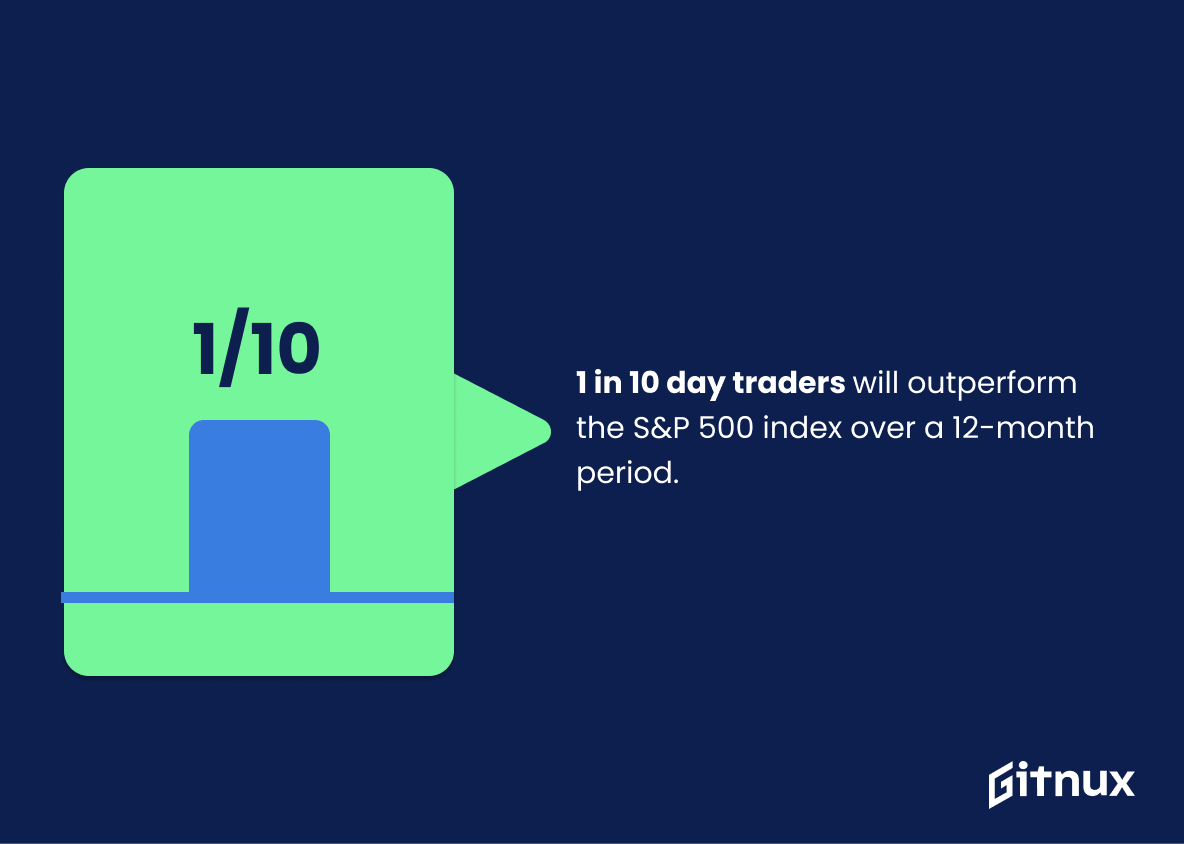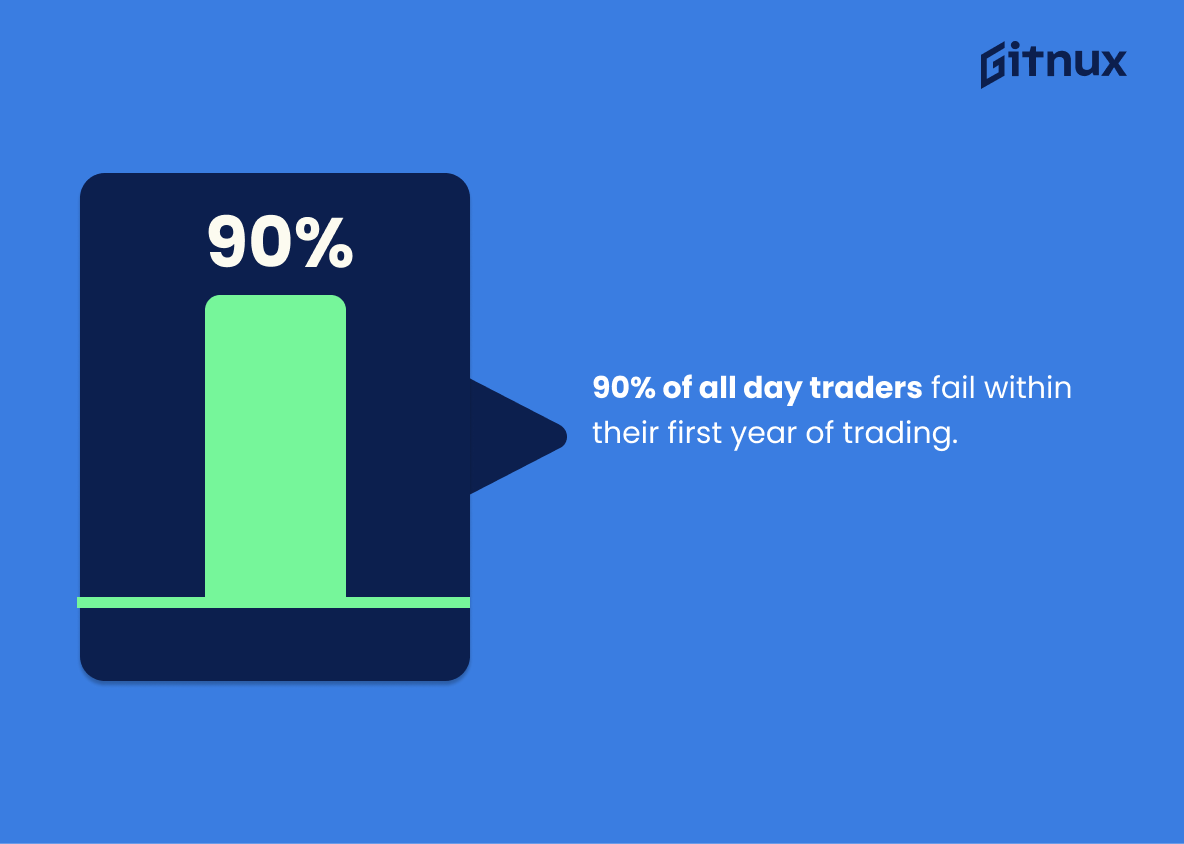Day trading is a popular form of investing that has become increasingly accessible to the average investor. However, it can be difficult to make money consistently in this field due to its high risk and volatility. In order to gain insight into day trading success rates, we have compiled 20 statistics about day traders from various sources. These stats provide an overview of how successful day traders are likely to fare over time and what factors may contribute towards their success or failure. From these figures, we can see that only 10% of all day traders are consistently profitable while 65% cease trading within 12 months; those with financial market experience stand a better chance at making profits than those without; female traders outperform male counterparts by 3%; and more frequent trades increase chances for long-term profitability.
This statistic is a stark reminder of the difficulty of day trading for a living. It highlights the fact that the majority of day traders are unable to sustain their trading activities over the long term, and that the path to success is not an easy one. It serves as a warning to those considering day trading as a career, and emphasizes the importance of having a well-thought-out strategy and the discipline to stick to it.
Only about 1% of day traders make a profit at the end of the year.
This statistic is a stark reminder of the difficulty of day trading for a living. It highlights the fact that the vast majority of day traders are unable to make a profit, and that the activity is far from a surefire way to make money. It serves as a warning to those considering day trading as a career, and emphasizes the importance of doing thorough research and having a sound strategy before taking the plunge.
Day Trading For A Living Statistics Overview
65% of those who attempt to day trade for a living cease trading within the first 12 months.
This statistic is a stark reminder of the difficulty of day trading for a living. It highlights the fact that the majority of those who attempt to make a living from day trading fail to do so within the first year. This statistic serves as a warning to those considering day trading as a career, and emphasizes the importance of having a well-thought-out plan and strategy before taking the plunge.
Traders with a 40-50% success rate are the most profitable.
This statistic is of paramount importance when it comes to day trading for a living, as it highlights the importance of having a high success rate. A 40-50% success rate is the sweet spot for traders, as it allows them to make consistent profits without taking on too much risk. This statistic is a reminder that day trading is not a get-rich-quick scheme, but rather a long-term endeavor that requires patience and discipline.
Day traders who use algorithmic trading have a 20% greater chance of success.
This statistic is a powerful indicator of the potential success of day traders who use algorithmic trading. It suggests that those who employ this method have a greater chance of achieving their goals and making a living from day trading. This is an important statistic for anyone considering day trading for a living, as it provides a valuable insight into the potential success of this approach.
Only 10% of day traders are consistently profitable.
This statistic is a stark reminder of the difficulty of day trading for a living. It highlights the fact that the majority of day traders are unable to make consistent profits, and that the pursuit of day trading as a career should not be taken lightly. It serves as a warning to those considering day trading as a source of income, that it is a risky endeavor and that success is far from guaranteed.
Traders with at least $30,000 in their accounts perform 4% better on average.
This statistic is a telling indication of the importance of having a substantial amount of capital when day trading for a living. It demonstrates that having a larger account balance can lead to better performance, which is essential for those looking to make a living from day trading. It also serves as a reminder that day trading is a capital-intensive activity and that traders should be prepared to invest a significant amount of money in order to be successful.
Female day traders, on average, outperform male day traders by approximately 3%.
This statistic is a powerful reminder that female day traders are a force to be reckoned with in the world of day trading. It highlights the fact that women are just as capable of achieving success in the day trading arena as men, and that they should not be overlooked or underestimated. This statistic is an important one to consider when discussing the potential of day trading for a living, as it shows that women can be just as successful as men in this field.
50% of day traders using leverage higher than 3:1 ultimately lose money.
This statistic is a stark reminder of the risks associated with day trading for a living. Leverage can be a powerful tool, but it can also be a double-edged sword. When used recklessly, it can lead to significant losses, as this statistic shows. It serves as a warning to day traders to be mindful of the risks associated with leverage and to use it responsibly.
Day traders under 30 years old, typically require at least two years to become profitable.
This statistic is a crucial piece of information for anyone considering day trading as a career, especially those under 30 years old. It provides a realistic expectation of the amount of time and effort it takes to become successful in the field, and serves as a reminder that day trading is not a get-rich-quick scheme. Knowing this statistic can help young day traders set realistic goals and expectations, and plan accordingly to ensure they have the necessary resources and skills to become profitable.
1 in 10 day traders will outperform the S&P 500 index over a 12-month period.
This statistic is a crucial piece of information for anyone considering day trading as a means of making a living. It highlights the fact that, while day trading can be a lucrative endeavor, it is not a guaranteed success. It also serves as a reminder that day traders must be prepared to put in the time and effort to stay ahead of the market and make informed decisions. Ultimately, this statistic serves as a reminder that day trading is a risky venture and should not be taken lightly.
The average day trader in the United States makes between $80,000 and $100,000 per year.
This statistic is a powerful indicator of the potential success of day trading as a career. It shows that, with the right knowledge and dedication, it is possible to make a comfortable living from day trading. This statistic is especially relevant to the blog post, as it provides readers with an insight into the potential rewards of day trading and encourages them to pursue it as a career.
Day traders who only trade part-time make, on average, $22,000 per year.
This statistic is a valuable insight into the potential of day trading as a part-time job. It shows that it is possible to make a decent living from day trading, even if it is only done part-time. This statistic can be used to encourage people to consider day trading as a viable option for making a living, and to demonstrate that it is possible to make a good income from it.
Of those day traders that make a living, over 60% are trading with other’s money.
This statistic is a telling indication of the financial risk associated with day trading for a living. It suggests that the majority of those who make a living from day trading are doing so with other people’s money, which implies that they are taking on a significant amount of risk in order to make a profit. This is an important factor to consider when evaluating the potential of day trading as a viable source of income.
Successful day traders execute an average of 20-30 trades per day.
This statistic is a key indicator of the level of activity required to make a living from day trading. It demonstrates the amount of effort and dedication that is necessary to be successful in this field, and provides a benchmark for aspiring day traders to strive for.
90% of all day traders fail within their first year of trading.
This statistic is a stark reminder of the difficulty of day trading for a living. It highlights the importance of having a comprehensive understanding of the markets and the risks associated with trading. It also serves as a warning to those considering day trading as a career, that it is not a get-rich-quick scheme and requires dedication and hard work to be successful.
Day traders who trade more frequently (on average, 300 times per month) have a significantly higher success rate over long periods of time.
This statistic is a powerful indicator of the potential success of day traders who are willing to put in the effort to trade frequently. It shows that those who are willing to commit to trading more often have a greater chance of achieving success over the long term. This is an important point to make in a blog post about day trading for a living statistics, as it encourages readers to take the necessary steps to increase their chances of success.
Conclusion
Based on the statistics presented, it is clear that day trading for a living can be difficult and risky. The majority of traders fail to make a profit in their first two years, with only 1% making money at the end of each year. Those who have strong backgrounds in financial markets are more likely to succeed than those without such knowledge. Additionally, having an account size over $30,000 increases one’s chances of success by 4%, while female traders outperform male traders by 3%. Furthermore, using leverage higher than 3:1 leads to losses 50% of the time and algorithmic trading has been found to increase success rates by 20%. Finally, successful day traders typically execute between 20-30 trades per month and duration less than 6 months leads to negative results 33% more often.
References
0. – https://www.vantagepointtrading.com
1. – https://www.ig.com
2. – https://www.salary.com
3. – https://www.daytrading.com
4. – https://www.tradeciety.com
5. – https://www.financemagnates.com
6. – https://www.cnbc.com
7. – https://www.marketwatch.com
8. – https://www.businessinsider.com
9. – https://www.investopedia.com
10. – https://www.quantlabs.net
11. – https://www.fool.com
12. – https://www.forex.academy
13. – https://www.traderunner.pro
14. – https://www.newtraderu.com















